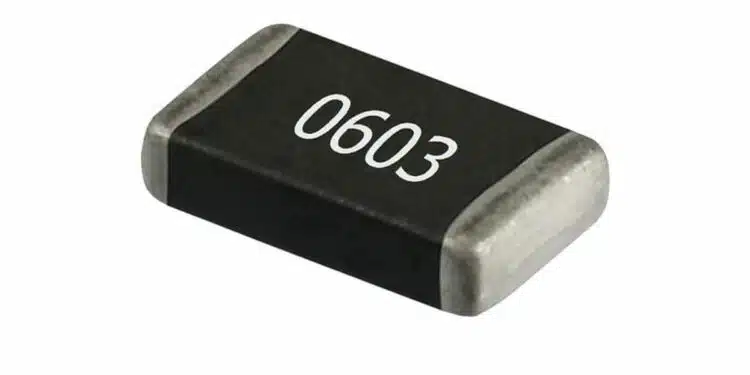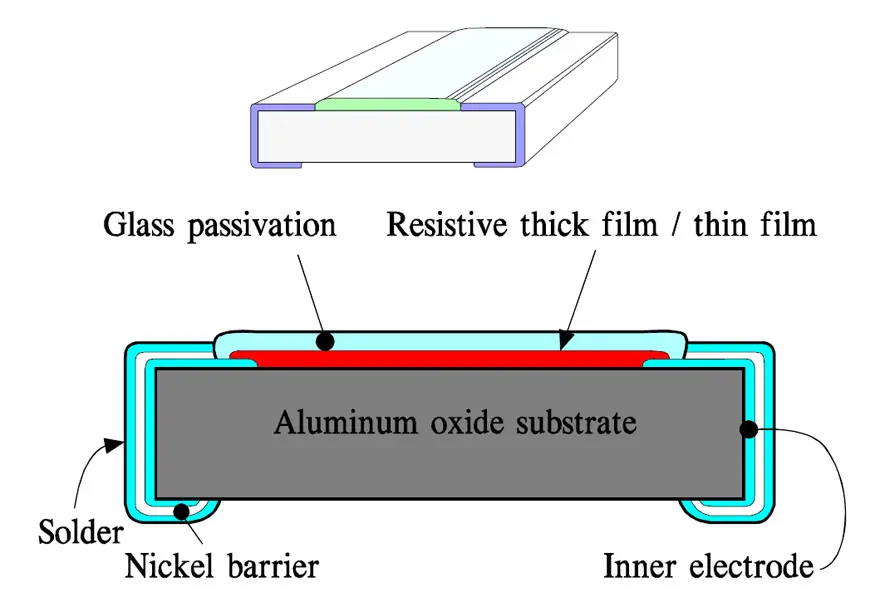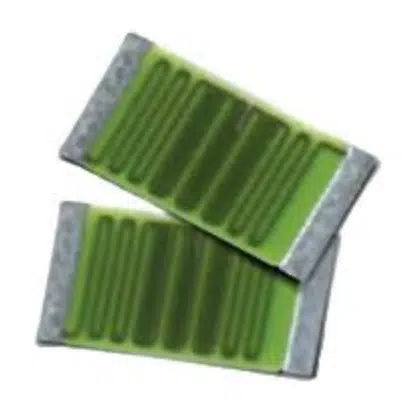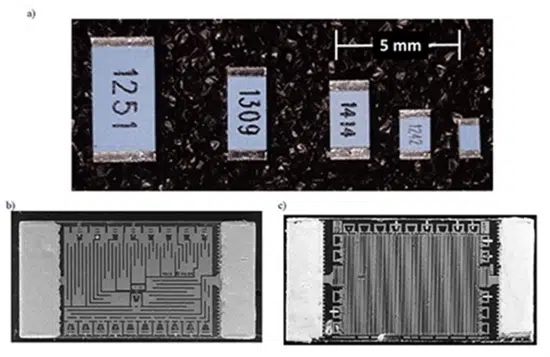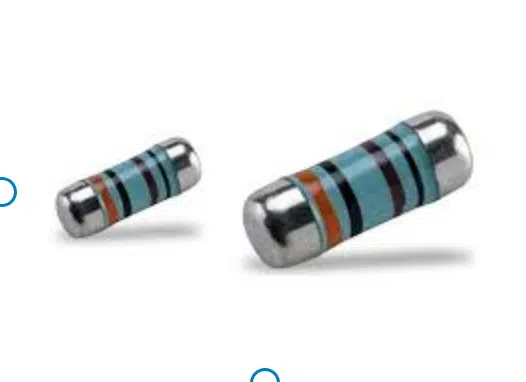MELF, SMD Resistors and Resistor Network allow a very large miniaturization. This in its turn means short conduction paths and good high frequency characteristics. Furthermore there are particular high frequency (HF) chips in thin film technique.
Fixed SMD resistors are manufactured in three basic designs:
- rectangular SMD chip
- cylindrical leadless, so called MELF (Metal Electrode Face Bonding)
- resistor networks
Introduction
Mounting / Soldering / Gluing
It is important to remember that SMD components, more than others, are influenced by temperature changes, especially for the larger component. Thus, dimensions and mounting directions are most important. Further, short and wide bodies are preferable to long and thin ones, partly for strength reasons, partly because of the inductance and with that the frequency dependence will decrease. Still another reason is that differences in the coefficient of expansion between substrate and chip decreases in significance with shorter distances between terminations.
The thermal dissipation may push the temperature in the solder joints above the detrimental 110…115 °C temperature range before we attain the nominal power PR. Permissible maximum power of a MELF resistor can be calculated from Equation [1]:

where:
- Ta = ambient temperature in °C
- RthS = thermal resistance of the solder joint, i.e., its temperature rise in K/W
- Pperm = permissible power
Information about thermal resistance of the solder joint of standard components applies to soldering conditions for normalized test board patterns.
Solderability is vital for a successful result. The user should use a wetting balance and international standard requirements at inspection. The end caps of MELFs sometimes have been difficult to solder. Metal glaze MELFs with metallized terminations generally have a better solderability.
SMD Cross Over Chips / “Jumpers”
Sometimes it’s necessary to complete existing application of printed circuits by separate short-circuiting between two points. Particular components are used, so called cross overs, cross conductors or jumpers, with the lowest possible resistance.
They exist both as rectangular thick film chips as well as metal film MELFs. Max resistance for the thick film chips usually is ≤50 mΩ at sizes between 0603 and 2010. Thin film MELFs in typical sizes of L x D ≈ 2 x 1.4 to 6 x 2.4 mm are specified for ≤10 mΩ.
As well as maximum resistance a maximum current is also specified for these components.
Failure modes
The weakest point of an SMD is the terminations and solder joints that break after sufficient temperature changes. Good components should stand at least 100 cycles between temperature limits. Applications like modern car electronics have forced the requirements up to some 1000…10 000 temperature cycles.
Except for failures resulting from open mode in connections and solder joints there always are failure modes typical for corresponding hole mount types.
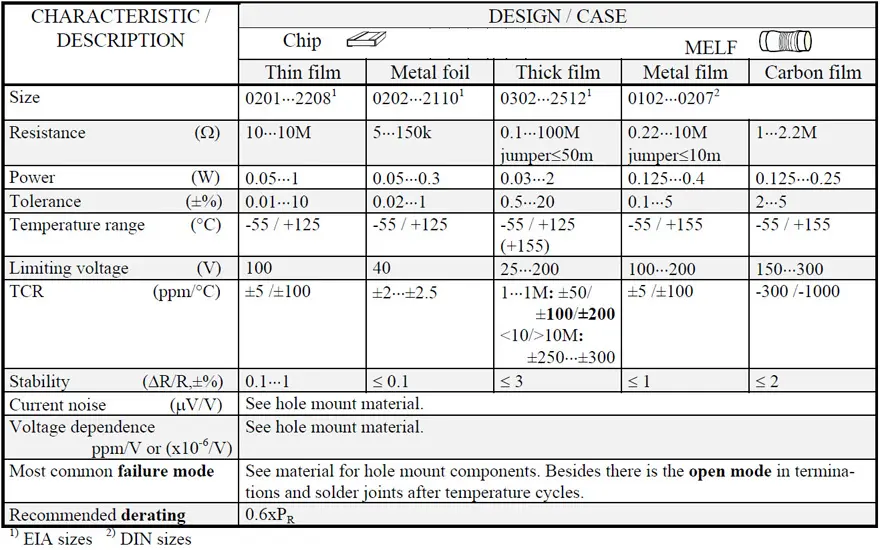
SMD Chip Resistors
The predominant part of all chips are manufactured with thick film, but thin film chips are becoming more and more common. Also metal foil exists as SMD. The construction is like the one in Figure 1. Certain types have an organic protection in one or two layers on top of the glass passivation.
The substrates are screen printed either with a metal powder paste that is fired to a metal glaze / thick film. Or metal foils are glued on a substrate or metal films are vaporized or ion implanted on it.
The thick film is laser trimmed to the right resistance value by cutting a track in the long side of the film. Recent manufacturing improvements however begin making this laser trimming unnecessary. This approach without any trimming tracks will increase the pulse load capability by 2 to 3 times. The other films are designed to an inductance-reducing serpentine pattern according to Figure 2. and 3.
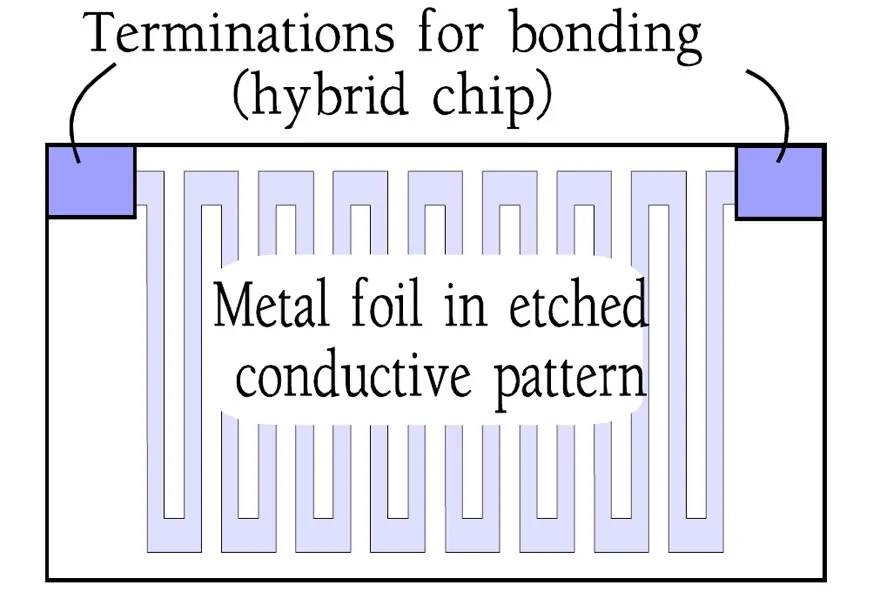
The metal foil pattern is etched chemically or patterned by means of an ion beam. The thin metal films are applied through a mask to the desired shape.
Linear PTC designs in metal glaze are marketed. Typical data are, for example, 10 kΩ and TCR +1500 ppm/°C. Metal film chips with resistance track in a serpentine pattern also exist. Typical EIA sizes are 0603, 0805 and 1206. Common TCRs range from +150 to +4500 ppm/°C while the corresponding maximum resistance values drop from 50 kΩ to 500 Ω. The higher TCR the lower the maximum resistance which depends on the film alloys that more and more are approaching the pure metal and its correspondingly lower resistivity.
Metal foil chips exist in two designs, partly as the wrap-around according to Figure 1., partly for use in integrated electronics (Figure 2.). In the latter case they are made with a protective glass passivation and with bonding pads which implies separate encapsulation.
A variant of bulk metal chips are used as current sensor. The resistance element consists of a metal plate that by laser cutting can be trimmed to tolerances of ±1% at resistance values in the range of 5 to 50 mΩ. The design and its tolerances require large chip dimensions (for example 0.4×0.2”).
Sometimes metal foil chips are delivered for special custom trimming by a scribed line.
Power chip resistors exist in thick film design. Common power ratings are 1 or 2 watts. The resistance range may cover 10 mΩ … 22 MΩ with tolerances between 1 and 10 %. The heat generation requires dimensions in the magnitude of 12 x 8 or 8 x 5 mm. The terminations usually consist of tinned compliant copper plates.
Sizes
With thick film chips the main focus has been moved from the EIA size 0805 (2 x 1.25 mm) to sizes 0603 (1.6 x 0.8) and 0402 (0.8 x 0.5). Discrete thick film chips are marketed down to 0302 or 0201 (0.8 x 0.5 respectively 0.6 x 0.3 mm). The most common chip size in thin film technology is 20 x 20 mil (0.5 x 0.5 mm; EIA code 0202) but are also found conventional EIA sizes from 0201 to 2010.
Reverse Geometry
Similar to small chip capacitors, also SMD resistors are offered in “reverse geometry” or sometime called “wide terminal” variants with wider side of the chip as the terminals. The design benefits are in these fields:
- lower ESL = lower parasitic and higher frequency range
- better thermal conduction into PCB = higher power rating by 30-50%
- higher mechanical strength = higher vibration and flex stress robustness
- less thermal stress as differences in the coefficient of expansion between substrate and chip decreases in significance with shorter distances between terminations.
The downside of the design, considering the high manufacturing price is now almost identical, is a significantly more difficult PCB cleaning process in narrow and long gaps between the termination pads.
Price comparison thick film – thin film
True price comparisons are difficult because of the difference between the characteristics tolerances and TCRs that are situated in different ranges. In general, thick film are cheaper to make but consume more of the material.
MELF Resistors
This component consists of a conventional resistor for hole mount, but in a form without leads. Instead one solders direct on the press-fitted naked end caps. At wave soldering the component body should be positioned with a glue lump (epoxy) to the substrate / printed circuit board.
Because the MELF design is a modified version of well-tried, well-established hole mount types, it in this SMD component assimilates all the good characteristics that characterize the respective basic hole mount type.
For metal film MELF this means among other things
- a wide resistance range
- low noise characteristics
- fine tolerances
- low TCR values
- good stability
With an extra thick metal film one has in some cases improved heat dissipation and also pulse capability. High frequency capability is achieved by a so called pulsed trim cut where the spiraled conductive pattern is broken in parts, thus reducing the inductive action from the helical trim cut and thus increasing the frequency range to several GHz.
MELF components are made in metal film, carbon film and metal glaze types. Usually they are supplied with end caps of conventional components but some manufacturers use metallized terminations.
Sizes
The MELF components were introduced as leadless metal film resistors in the DIN size 0207. Today 0204 (1.5 x 3.6 mm) is the most common, not least because of its smaller risk of open mode failure in the solder joints after frequent temperature changes. However, the size 0102 (1.1 x 2.2 mm) is already well established in the consumer market.
Price comparisons
Hole mount : MELF ≈ 2 : 3.

Resistor Networks
By a network we mean several separate or mutually connected resistor elements collected in a common casing and supplied with terminal leads to each element. Usually the elements have the same resistance value but different values may exist, for example a number of R1 and R2 connected in a ladder pattern that gives a certain voltage division.
In hybrid manufacturing the customer himself applies the resistor elements in a desired casing.
General comments
Resistor networks are manufactured both for hole mount and as SMDs. Most parts are manufactured in thick film but thin film as well as metal foil types have a good market.
Discrete SM components may be mounted in the network package. But usually the planar substrates are screen printed with a network pattern either with a metal powder paste that is fired to metal glaze/thick film. Or metal foils are glued to the planar substrate or metal films of NiCr or Ta2N are vaporized or ion implanted – sputtered – on the substrates. The thick film is laser trimmed to the desired resistance value by cutting a track in one of the long sides of the film. However, just as with the discrete chips improved manufacturing technology begins making this laser trimming unnecessary. The other films are designed to a serpentine pattern which reduces the inductance of the element. The metal foils get their pattern by a chemical etching process or by means of the cleaner ion beam etching. The thin metal or metal oxide films are applied through a mask to desired shape.
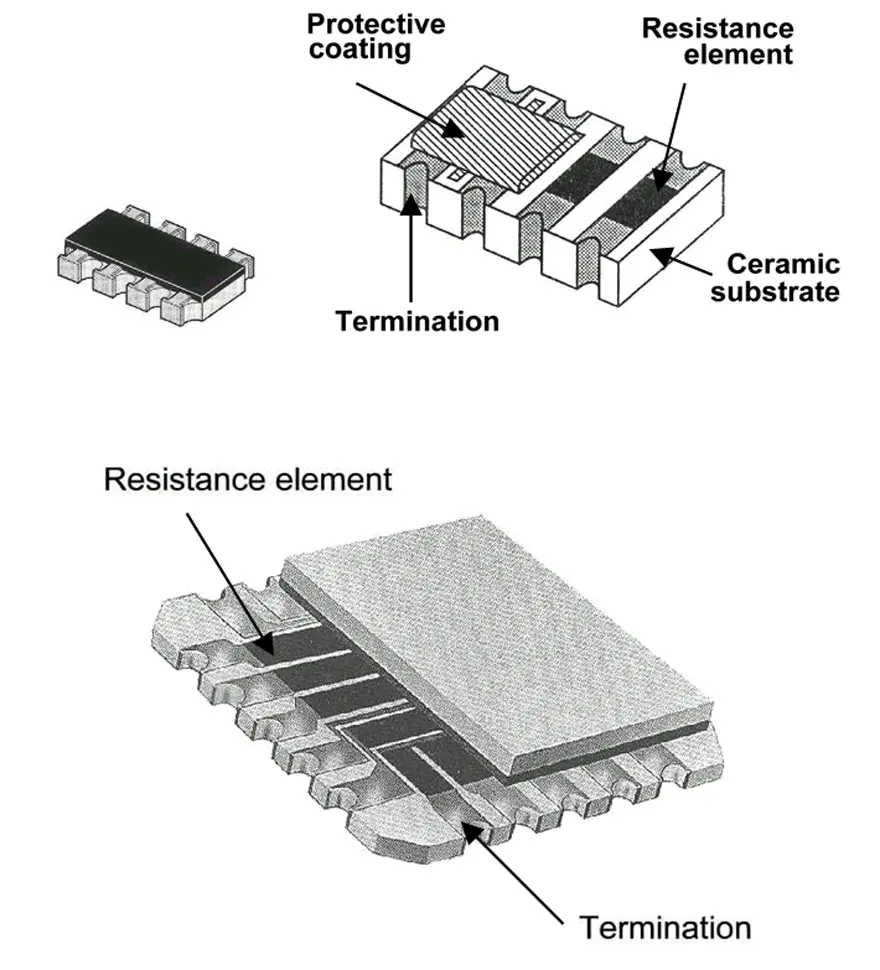
Just as the chips the resistor element films are protected by a glass coat or sometimes a tantalum oxide coating.
Designs
DIL (sometimes DIP) stands for Dual-In-Line respectively Dual-Inline Package (Figure 10.). The number of leads varies; most common are 14, 16 or 18 leads.
SIL or SIP means Single-In-Line respectively Single-Inline-Package. This network requires less surface but a higher building profile. It exists in the profiles 8 and 5 mm. The latter is most popular. A common number of leads are 4, 6, 8, 10 or 12 (Figure 11.).
SMD networks exist in many different designs. Some are shown in Figures 8. and 9. . If the application implies considerable temperature changes examples like those in Figure 8. should, due to their lack of flexible leads, be mounted on ceramic substrates.
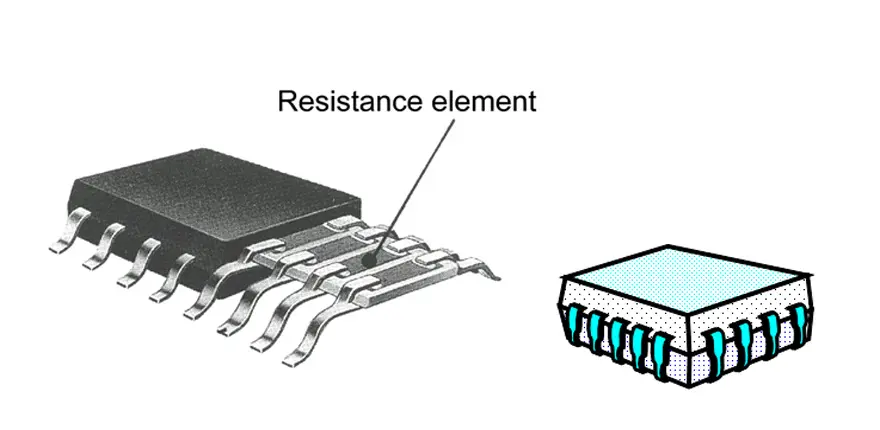
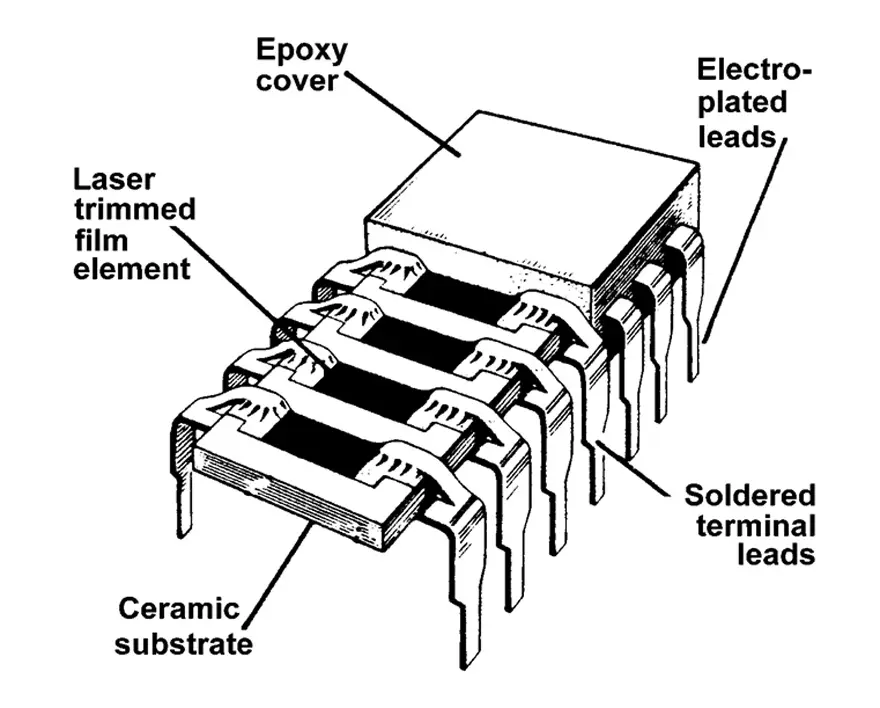
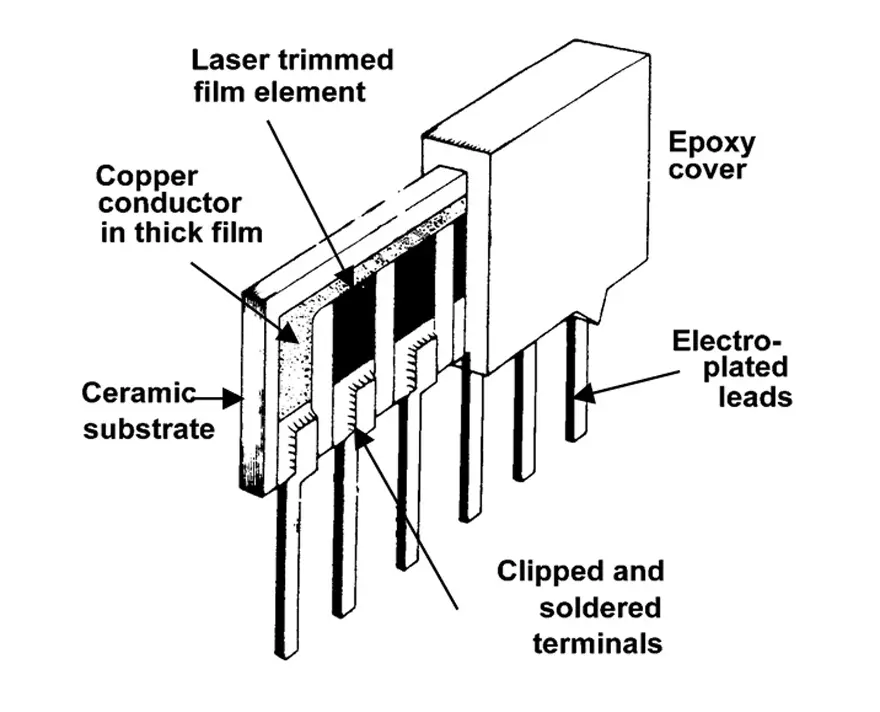
Of all requirements that have to be specified and checked there is one that is of particular interest: The coplanarity , i.e., the mutual planarity of the leads relatively to a reference plane. If this measure is not met – d in Figure 12. – some leads will be suspended in the air at soldering to the substrate. The measure is exemplified by the gull-wing shape but applies as well to the J hook design.
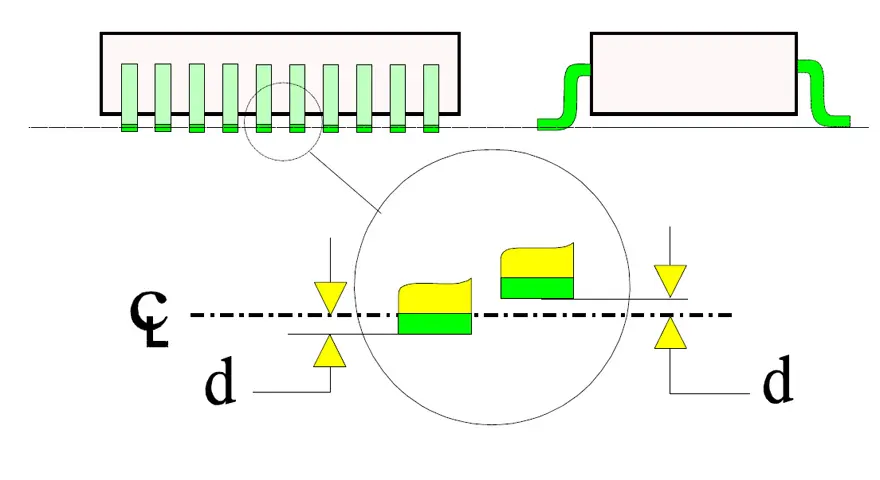
Configurations
The electrical circuit can be arranged in an infinite number of ways. Usually the resistor values are mutually equal. Sometimes they are bussed (common neutral), sometimes they are arranged separately. Figures 13. to 18. show examples of the most common configurations.
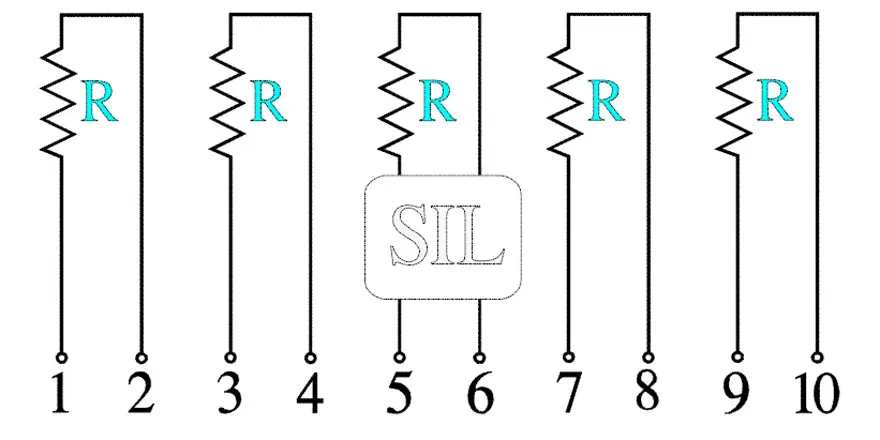
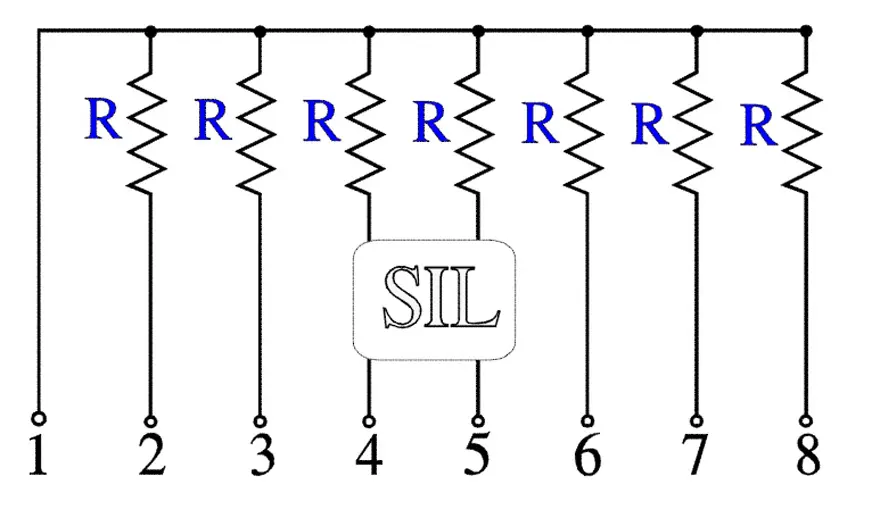
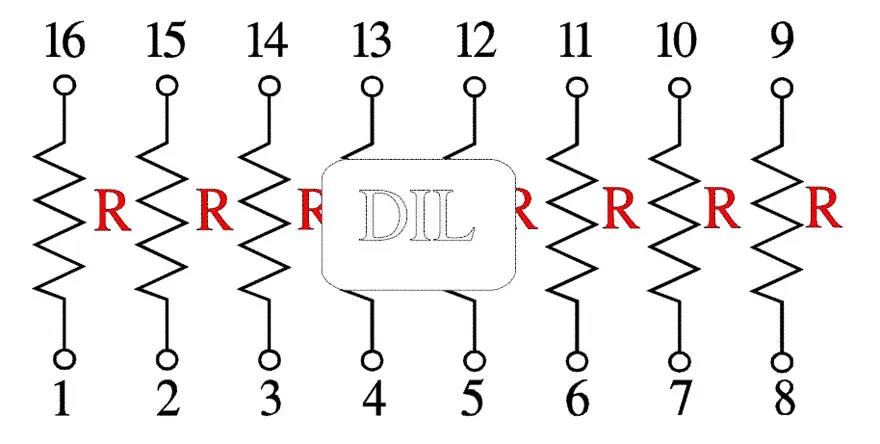
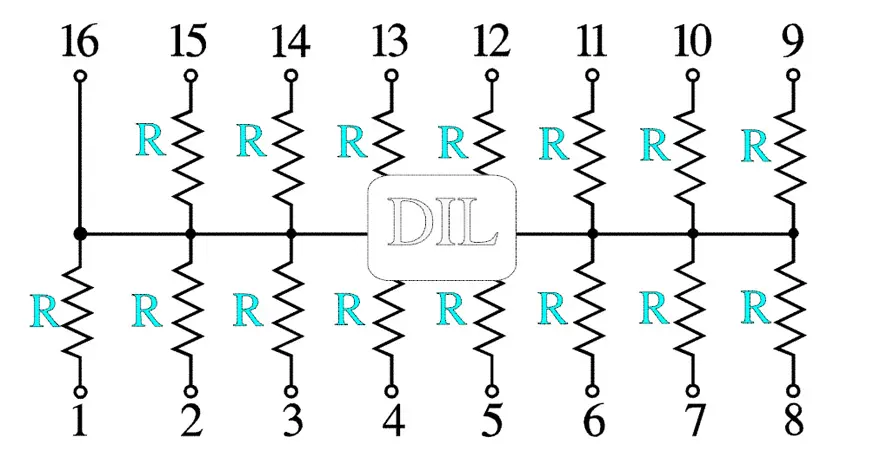
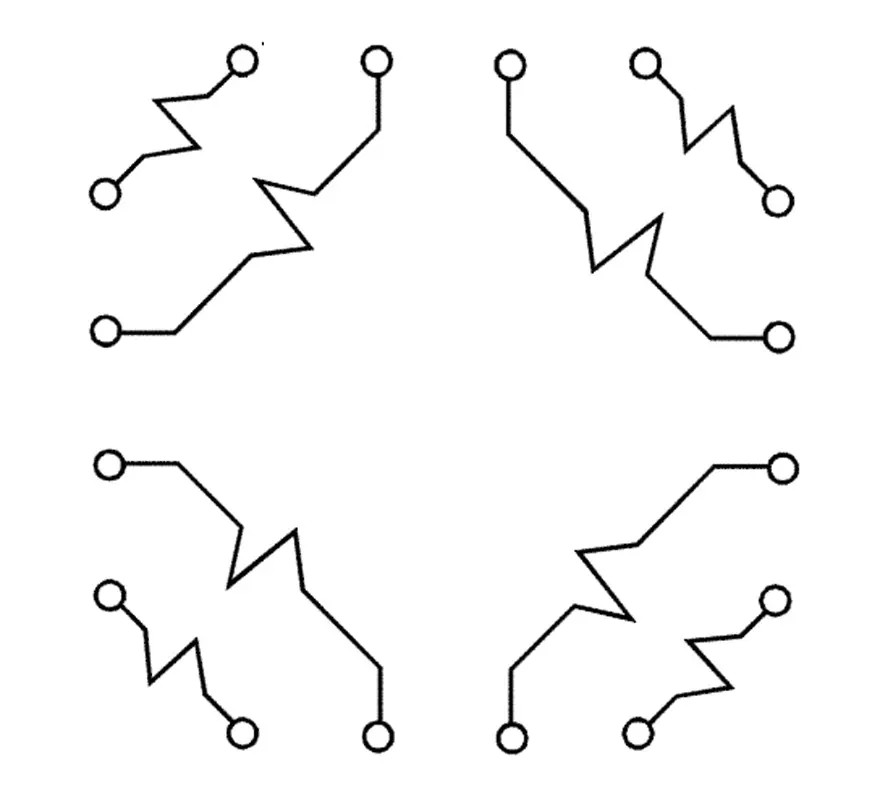
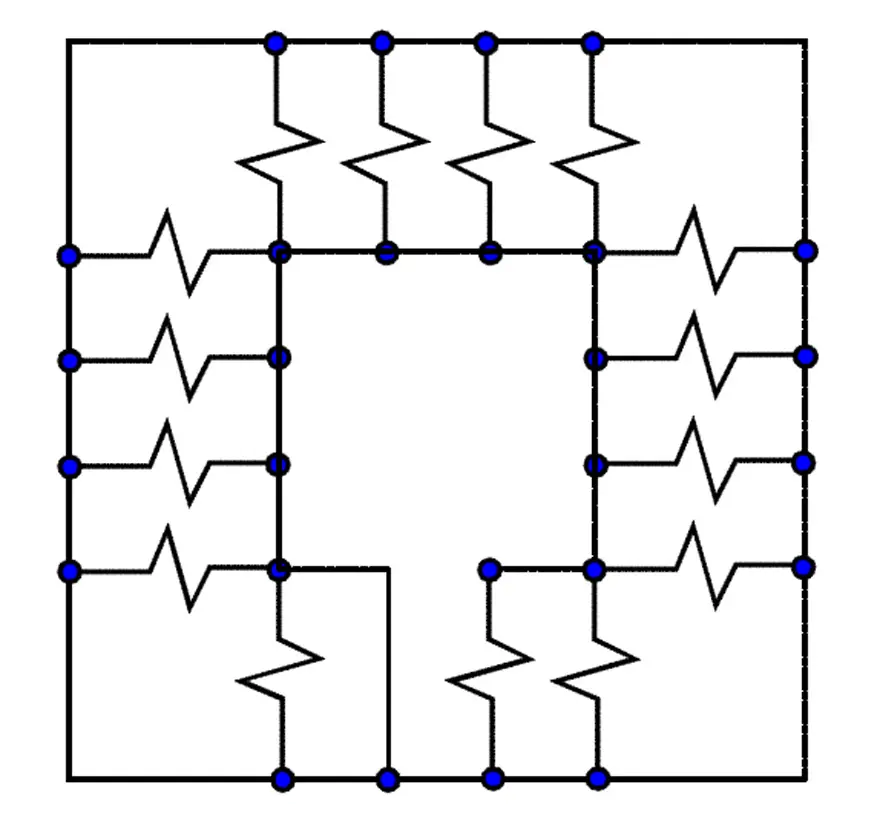
Characteristics
In the first place the characteristics of the networks are determined by the resistor material that rules the TCR and the absolute tolerance. Because the elements included belong to the same manufacturing batch their parameter distribution is much more limited than that of the total production. This enables an additional kind of specification that often is used with precision components: the resistance ratio or relative tolerance and the TCR tracking. The concepts are illustrated in Figures 19. and 20.
In order to understand the resistance ratio concept better we should recollect how the absolute tolerance is constructed. If the actual resistance is called R and the nominal resistance Rnom, the ratio R/Rnom should be within the tolerance limits. With the relative tolerance, however, we mean a comparison of the different element resistances, Rr, with a reference element, Rref, in the network. Rref usually is the first element in the schematic.
The ratio Rr/Rref is called the resistance ratio accuracy, ratio tolerance (or relative tolerance) and is expressed in percent. It is a comparison of magnitude and therefore is given without a sign. If the element values of the network are distributed as in Figure 19. we realize that the largest spread will occur if Rref = Rmin and Rr = Rmax. Thus the resistance ratio accuracy, Rratio, shall fulfill the condition (Rmax – Rmin)/Rmin ≤ Rratio.
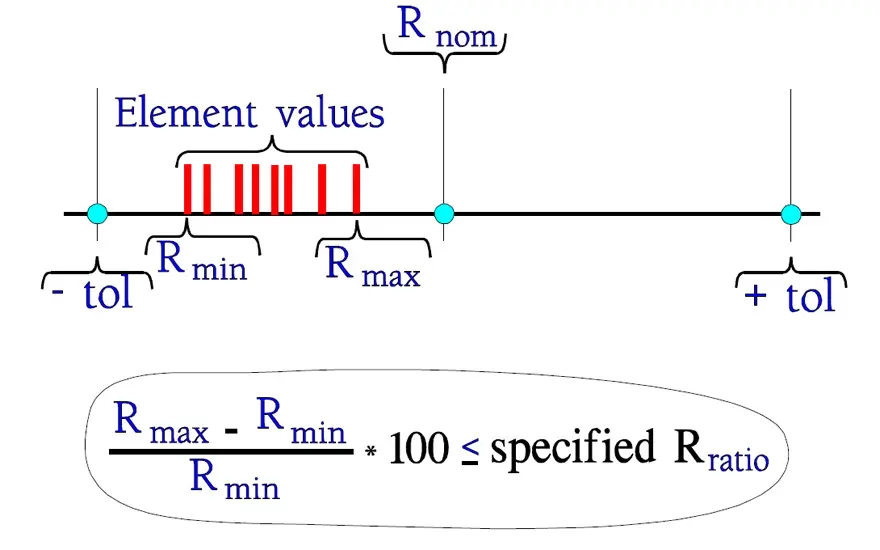
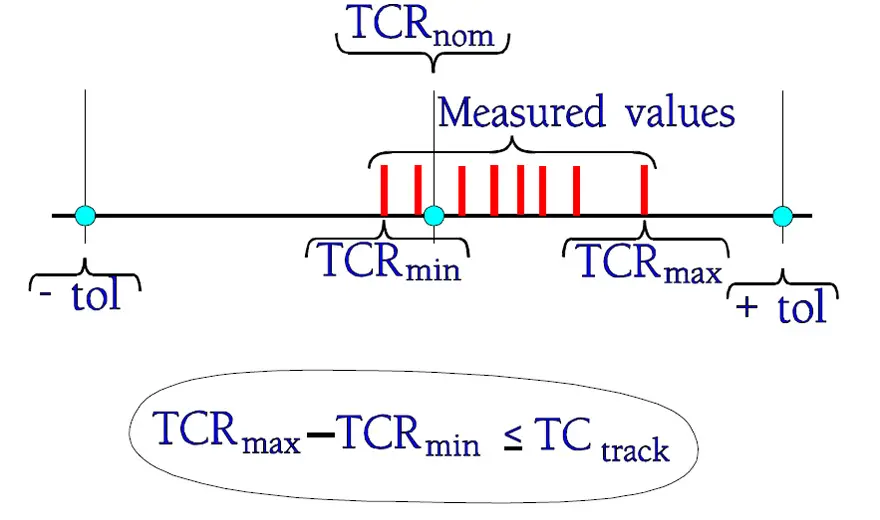
The resistance ratios may range over 0.2 to 2 % for the thick film networks and between 0.05 and 1 % for the thin film networks. The TCR tracking, i.e., the reciprocal TCR differences between the elements, is illustrated in Figure 20.
In practice the following rule of thumb often applies: TCRtrack ≈ ½ x TCRabs where TCRabs means specified absolute TCR.
TCRtrack for the thick film networks usually lies between 10 and 50 ppm/°C and for the thin film networks between 0.5 and 10 ppm/°C.
Failure modes
Soldering risks
Terminations with the usual pitch 0.1″ (2.54 mm) are subjected to a mutual thermal influence at soldering. For SMD networks there will in addition be the closeness to the substrate and the solder pads. Thus, networks run an increased risk of melting internal solder joints. Even if they will solidify after the soldering process there always is a risk of resulting dry joints. Usually this problem is avoided by specifying use of an internal solder with a melting point well above that of the external solder alloy.
Mechanical weaknesses
The ceramic substrates used often are relatively long and thin. Thermal and mechanical shocks as well as vibration may cause cracks in the ceramic under resistor elements and terminations and result in open modes that in the worst case are intermittent and temperature dependent (the nightmare of trouble shooting). Through hole mounted SIL networks run an extra risk of mechanical damage (if somebody, for example, wants to reposition a network that leans after soldering!).
Mechanically exposed designs sometimes are molded in epoxy, foamed plastic or equivalent. Even if the component surfaces are covered with a mould release agent that is intended to prevent the molding compound to get hold of the components due to shape changes during the hardening process it doesn’t solve the problem with, for example, SIL networks. They are very easily exposed to unsymmetrical side forces that may crack the ceramic substrate.

Integrated Resistors
In electronics the following trend is prevailing. Working voltages are becoming lower and lower and operating frequencies increase at the same time as downsizing is a key word when delay of electric signals between the active components has to be reduced. The discrete passive components are also becoming smaller and smaller and the component density on the interconnecting substrate increases. This will cause an increase in production cost and failure risk at the same time as the probability of crosstalk grows due to unexpected parasitic capacitances and stray inductances. One step to solve these problems is the use of resistor networks. Next step is to integrate passive components in the printed circuit boards.
On ceramic boards integrated components are no novelty. Integrated resistors and capacitors are common in thick film and thin film circuits. The sheet resistivity of thick film resistors usually ranges from 10 Ω/square to 1 MΩ/square . Values down to 0.5 Ω/square and up to 1 GΩ/square are, however, quite possible. Generally one prints with a width of 0.5 to 1 mm (20 to 40 mils). Then sheet resistivity and element length (number of squares) determine the wanted resistance.
There are now thick film materials available that can be screen printed on polymeric substrates.
In recent years another method of integrating resistors is introduced that is called buried resistors technology. It is intended for large scale production and works with polymeric substrates on which are printed laminates that consist, at the bottom, of a resistive alloy and, on top, of an electrically conductive copper film. The art work of the resistive elements and their terminals are produced by means of photoplot and etching. The resistive film consists of a nickel phosphorus alloy with sheet resistivities of 25 or 100 Ω/square and corresponding thicknesses of 0.4 and 0.1 mm (16 and 4 microinches). By arranging a number of such squares to a bar or serpentine geometry one can create resistance values of hundreds or thousands of ohms. A width may range between 0.2 and 2 mm (8 and 80 mils).



















